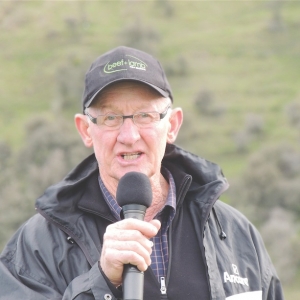Speaking to a Beef + Lamb New Zealand field day in South Canterbury recently Otago consultant Errol Holgate outlined the advantages of such a system, and exactly which ewes should be going into the B flock.
Get it right and the benefits rapidly compound in a more efficient A flock producing more and better lambs. Meanwhile the B flock provides a flexible class of stock that can be used to do a job or be offloaded if feed is tight.
Holgate’s approach is to select ewes on efficiency, and not just the weight of lamb they rear relative to ewe bodyweight or scanning results.
“It’s about how much feed they use from weaning to winter, so they’re not taking feed off other stock. In all ewe flocks some of the best condition ewes are inefficient and some top scanning ewes are inefficient. They can look great and scan great but still be inefficient. What you need is a system to track the animals that let you down and those that never let you down.”
Assuming ewes are first lambed as two-tooths, the first step is to tag any two-tooth that scans a single. “She’s on trial for 12 months. You can’t afford to put her straight into the cull mob because she may never have another single.”
Similarly, older ewes that scan a single get a tag.
“You want to know if she’s one of those ewes that every year they have twins they have a single the year after to get over it. If they do that over their lifetime they’re only scanning 150% and we want more than that.”
The second “more important” step is drafting ewes on condition at weaning, giving light ewes a different coloured tag to the singles. If they’re light, and had a single, they get a black tag and go straight into the B flock, or “terminal mob.”
If they’re light but reared twins, they get a different coloured tag. If they then scan a single, they go into the B flock, as do any four-tooths or older ewes that scan single having also scanned single as a two-tooth.
Turning up skinny at second or subsequent weanings, having done it once (as identified by your tagging system) is also a black tag offence.
“You need different systems to weed out those low fertility ewes that are always in good condition and those that are repeat offenders on body condition.”
While it’s a common argument that those skinny ewes are skinny because they’ve probably reared great twin lambs, in a commercial system few farmers have any way of checking that and research has shown that often that’s not the case, Holgate told Rural News after the field day.
“We need ewes that can do both: milk well, rearing good lambs and hold condition while doing so.”
A third point for B flock selection is conformation. “You’ll get some ewes that hold condition but the conformation of the ewe, regardless of how good the ram is, will decrease the flexibility you have with her lambs.”
Age doesn’t come into his selection system, as an old ewe that can maintain condition and repeatedly rear twins is exactly the sort of sheep you should be breeding from as effectively you’re adding longevity to your selection criteria for replacements.
“A lot of farmers traditionally put their older ewes to the terminal sire, the thinking being they can wean them early and get the old ewe away, but those old ewes that haven’t collected any tags (ie never light or scanned single) during their lifetime are the best ewes on the farm. You have to ask yourself do you want the chance to get another ewe lamb or two from her.”
That said, when it does come to selecting culls, tags identifying a previous offence such as having a single or turning up light, will help prioritise decisions.
Holgate says his system means replacements are only bred from good ewes, resulting in more even lines at weaning with a reduced “tail-end”. Feeding requirement of the flock is no longer focused on the bottom end ewes, and with each generation the flock becomes more efficient. More efficient ewes will be cheaper to feed and provide more flexibility from weaning to winter.
“You can ask them to do a job for a short burst and not worry that the bottom 10-20% are going to lose condition,” he told the field day.
Meanwhile the B flock, put to terminal sires, produce better lambs too, thanks to hybrid vigour despite the ewes’ flaws (light, poor conformation or single scanning). Singles will be away earlier helping cashflow and easing feed demand.
The B flock also represents a class of stock that can be sold at almost any point in the year if the season dictates, adding flexibility that will help avoid having to sell capital stock.
“The moment she becomes a B ewe I call her a trading ewe.”

















